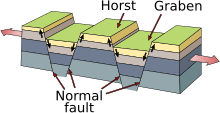構造沉降
外观
構造沉降(英語:tectonic subsidence)是地殼相對大地水準面的大規模下沉[1]。 地殼板塊運動和斷層[2] . 形成的大規模沉降能在多種環境中造成,包括被動邊緣、拗拉槽、弧前盆地、前陸盆地、洲際盆地和拉張盆地。 造成的機制常見有三種:伸展、冷卻和加載[3][4]。
機制
[编辑]擴張
[编辑]
正斷層能由地壘和地塹系統來延伸地殼。而岩石圈也經由在正斷層或裂陷中心發展水平延伸。一個延伸的地區,同時也減少了該區厚度。因而導致較薄的地殼下沉[3]。
冷卻
[编辑]在裂谷形成中,岩石圈被拉伸而減薄導致岩石圈的區域頸縮(上下界面界面相互接近)。下伏的軟流圈也被動的上升以取代變薄岩石圈在的地幔。隨後,在裂谷/伸展期結束後,在淺層的軟流圈逐漸冷卻回歸到地幔。由於岩石圈中的地幔比軟流圈地幔更緻密,這種冷卻會導致沉降。這種現像被稱為“熱沉降” [5]。
加載
[编辑]
沉積物的堆積或造山運動均能加載地殼的負荷重量,因而導致地殼凹陷和沈降。沉積速度和幅度控制沉降的速度 [6]。 在造山運動中,岩層局部的堆積成山對地殼也增加產很大的負荷,導致岩石圈彎曲凹陷[2]。
參考文獻
[编辑]- ^ Makhous, M.; Galushkin, Y. (2005). Basin analysis and modeling of the burial, thermal and maturation histories in sedimentary basins. Editions TECHNIP. p. 66. ISBN 978-2-7108-0846-6. Retrieved 18 November 2011.
- ^ 2.0 2.1 Xie, Xiangyang; Heller, Paul (2006). "Plate tectonics and basin subsidence history". Geological Society of America Bulletin. 121 (1–2): 55–64. doi:10.1130/b26398.1
- ^ 3.0 3.1 Ceramicola, S.; Stoker, M.; Praeg, D.; Shannon, P.M.; De Santis, L.; Hoult, R.; Hjelstuen, B.O.; Laberg, S.; Mathiesen, A. (2005). "Anomalous Cenozoic subsidence along the 'passive' continental margin from Ireland to mid-Norway". Marine and Petroleum Geology. 22 (9–10): 1045–67. doi:10.1016/j.marpetgeo.2005.04.005.
- ^ Lee, E.Y., Novotny, J., Wagreich, M. (2019) Subsidence analysis and visualization: for sedimentary basin analysis and modelling, Springer.doi:10.1007/978-3-319-76424-5
- ^ McKenzie, D (1978). "Some remarks on the development of sedimentary basins". Earth and Planetary Science Letters. 40 (1): 25–32. Bibcode:1978E&PSL..40...25M. CiteSeerX 10.1.1.459.4779. doi:10.1016/0012-821X(78)90071-7.
- ^ Kim, Y., Huh, M., Lee, E.Y. (2020) Numerical Modelling to Evaluate Sedimentation Effects on Heat Flow and Subsidence during Continental Rifting. Geosciences 10, 451 https://www.mdpi.com/2076-3263/10/11/451 (页面存档备份,存于互联网档案馆)
